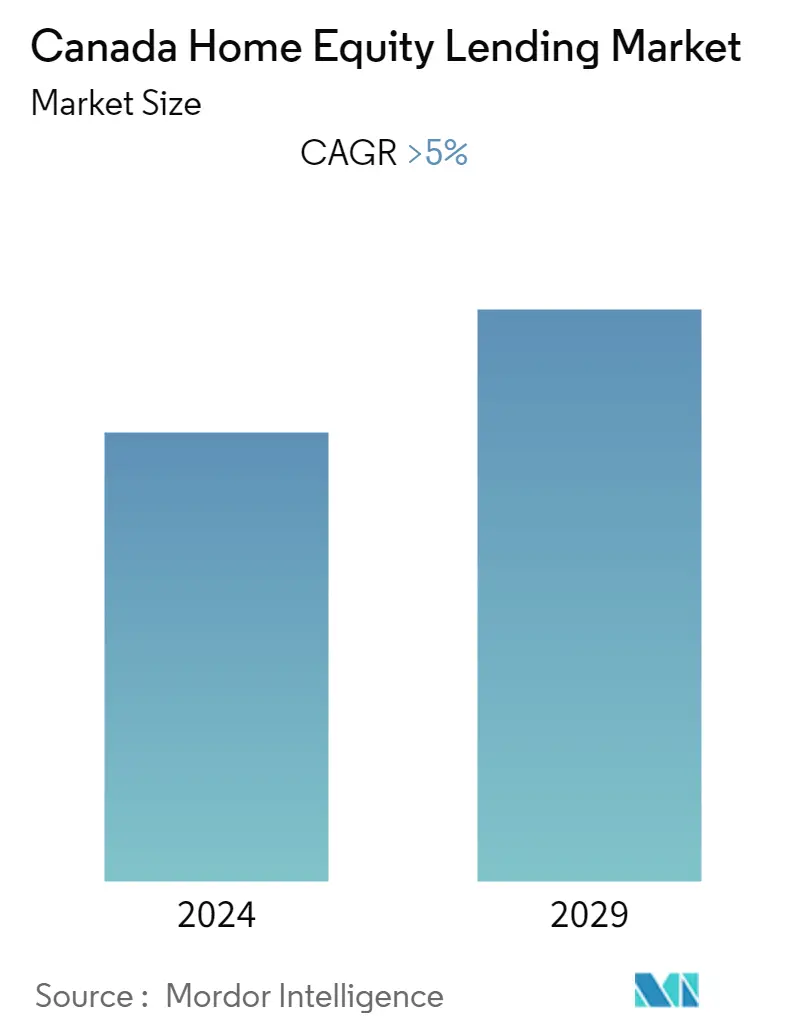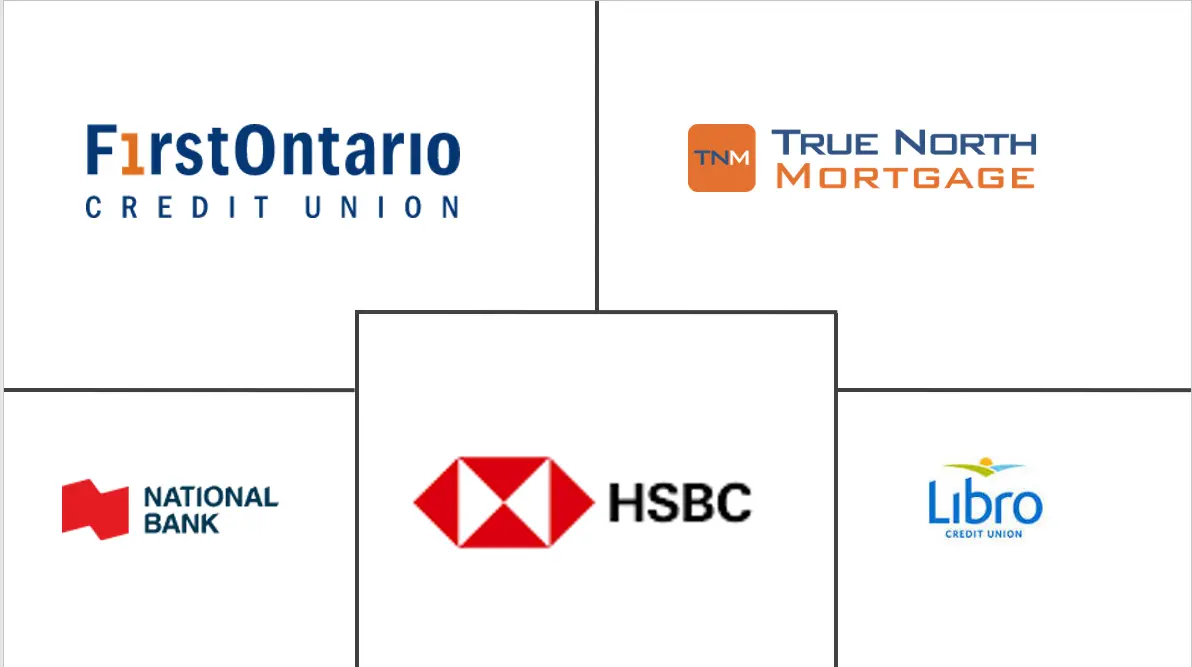Market Size of Canada Home Equity Lending Industry

| Study Period | 2020 - 2029 |
| Base Year For Estimation | 2023 |
| Forecast Data Period | 2024 - 2029 |
| Historical Data Period | 2020 - 2022 |
| CAGR | 5.00 % |
| Market Concentration | Medium |
Major Players
*Disclaimer: Major Players sorted in no particular order |
Home Equity Lending in Canada Market Analysis
Housing prices in Canada have increased in the past 4 to 6 years, after a long period of Stagnation. This rise, while moderate in comparison to those seen in other countries, has been fuelled by increased mortgage debt.
Since the pandemic, around 16% of mortgages in Canada have been deferred, and 40% could not pay due to a pandemic-related decline in household income. Arrears rates of expired deferrals are below rates that prevailed before the COVID19 pandemic. Of expired deferrals that are at least 30 days behind in payment, installments loans and auto loans among renters have the highest rates of arrears.
Higher real estate values and the lowering of regulatory restrictions are encouraging Canadians to use their homes as collateral for loans. In February 2022, the seasonally adjusted balance of home equity lines of credit increased 1% to USD 128 billion. Residential mortgage debt accounts for 74% of all household debt in Canada, which helps to build net worth, whereas lines of credit account for 16% and credit card debt accounts for 4%.
New mortgage rules have been implemented in 2022, making it more difficult for Canadians to access their home equity via traditional methods. These requirements also came with increased interest rates, making it more difficult than ever to qualify for a home equity line of credit solutions. One of the changes is that Canadians now must be able to pay off their home equity line of credit within 25 years under the new rules.
Home Equity Lending in Canada Industry Segmentation
A home equity lending is a type of loan in which the borrower uses the equity of their home as collateral. The loan amount is determined by the value of the property, and the value of the property is determined by an appraiser from the lending institution. Canadian Home Equity lending Market is segmented by type (Fixed rate loan and home equity lines of credit), by Service Providers (Commercial banks, Financial Institutions, Credit Unions, and other creditors), and by Mode (Online and Offline).
| By Type | |
| Fixed rate loan | |
| Home equity lines of credit |
| By Service Provider | |
| Commercial banks | |
| Financial Institutions | |
| Credit Unions | |
| Other Creditors |
| By Mode | |
| Online | |
| Offline |
Canada Home Equity Lending Market Size Summary
The home equity lending market in Canada is experiencing a dynamic phase, driven by rising housing prices and increased mortgage debt. Over the past few years, Canadian housing prices have seen a moderate increase, spurred by the use of homes as collateral for loans. This trend has been further supported by the easing of regulatory restrictions, encouraging more Canadians to leverage their home equity. Despite the challenges posed by the pandemic, such as mortgage deferrals and a decline in household income, the market has shown resilience. The balance of home equity lines of credit has seen a notable increase, reflecting the growing reliance on home equity as a financial resource. However, new mortgage rules implemented in 2022 have made it more challenging for Canadians to access home equity through traditional methods, with increased interest rates and stricter repayment terms.
The market landscape is characterized by the presence of major players such as HSBC Bank, National Bank of Canada, and First Ontario Credit Union, who dominate the market share. These institutions are increasingly focusing on technological advancements and product innovation to expand their market presence. The merger between First Ontario Credit Union and Heritage Savings & Credit Union, along with partnerships like that of Hello Safe and Hard Bacon, highlight the strategic moves being made to enhance service offerings and tap into new markets. The growth of home equity lines of credit and combined mortgages underscores the market's expansion, with low-interest rates playing a crucial role in this resurgence. As the market continues to evolve, these key players are likely to maintain their influence while adapting to the changing regulatory and economic landscape.
Canada Home Equity Lending Market Size - Table of Contents
-
1. MARKET DYNAMICS AND INSIGHTS
-
1.1 Market Overview
-
1.2 Market Drivers
-
1.3 Market Restraints
-
1.4 Insights on Various Regulatory Landscape
-
1.5 Insights on impact of technology and innovation in the market
-
1.6 Industry Attractiveness - Porters' Five Forces Analysis
-
1.6.1 Threat of New Entrants
-
1.6.2 Bargaining Power of Buyers
-
1.6.3 Bargaining Power of Suppliers
-
1.6.4 Threat of Substitutes
-
1.6.5 Intensity of Competitive Rivalry
-
-
1.7 Impact of COVID-19 on the Market
-
-
2. MARKET SEGMENTATION
-
2.1 By Type
-
2.1.1 Fixed rate loan
-
2.1.2 Home equity lines of credit
-
-
2.2 By Service Provider
-
2.2.1 Commercial banks
-
2.2.2 Financial Institutions
-
2.2.3 Credit Unions
-
2.2.4 Other Creditors
-
-
2.3 By Mode
-
2.3.1 Online
-
2.3.2 Offline
-
-
Canada Home Equity Lending Market Size FAQs
What is the current Canada Home Equity Lending Market size?
The Canada Home Equity Lending Market is projected to register a CAGR of greater than 5% during the forecast period (2024-2029)
Who are the key players in Canada Home Equity Lending Market?
HSBC Bank Canada, Tangerine Direct Bank, National bank of canada, First Ontario Credit Union and B2B Bank are the major companies operating in the Canada Home Equity Lending Market.

